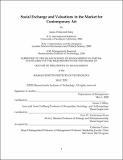| dc.contributor.advisor | Susan S. Silbey and Ezra W. Zuckerman Sivan. | en_US |
| dc.contributor.author | Riley, James Whitcomb. | en_US |
| dc.contributor.other | Sloan School of Management. | en_US |
| dc.date.accessioned | 2020-09-03T16:46:40Z | |
| dc.date.available | 2020-09-03T16:46:40Z | |
| dc.date.copyright | 2020 | en_US |
| dc.date.issued | 2020 | en_US |
| dc.identifier.uri | https://hdl.handle.net/1721.1/126977 | |
| dc.description | Thesis: Ph. D., Massachusetts Institute of Technology, Sloan School of Management, May, 2020 | en_US |
| dc.description | Page 115 blank. Cataloged from PDF version of thesis. | en_US |
| dc.description | Includes bibliographical references. | en_US |
| dc.description.abstract | The first essay draws on 18 months of ethnographic fieldwork to examine the puzzle of why galleries discipline collectors -- | en_US |
| dc.description.abstract | who provide much-needed financial capital - for appearing too motivated by profit. Whilst art worlds have strong norms that enjoin artists to avoid the naked pursuit of profit and instead affect an air of "disinterestedness" (that is, a concern only for universal virtues and aesthetic qualities such as truth and beauty), why might art dealers demand that collectors similarly conform to such norms? This study addresses how (and why) galleries enforce conformity to the art-world norm of disinterestedness among collectors as part of an array of tactics they deploy to "protect" their artists from price volatility that could depress demand for the artist's work. The findings suggests a paradoxical resolution. Although galleries framed such discipline as a moral imperative, a key implication of this study is that enforcing a norm that disavows extrinsic rewards such as fortune and fame ultimately supports a profitable business and investment strategy. | en_US |
| dc.description.abstract | The second essay (coauthored with Ezra W. Zuckerman Sivan) also draws on an 18-month ethnographic investigation examining the rise and proliferation of International Art Fairs (IAFs) in the global art market. This study contributes to our understanding of how the construction and extension of market platforms shapes market dynamics. On the surface, the explosive growth of IAFs in the contemporary art market reflects the greater efficiency that market platforms typically offer, both for facilitating exchange and for expanding access. But past research on market construction does not prepare us for either of the two main findings of this paper. The first is that market participants (and especially the mid-size galleries that dominate the fairs) are deeply ambivalent about the fairs' value relative to the cost of participation. The second main finding -- that galleries (and others) believe they must participate in order to be visible in the market -- | en_US |
| dc.description.abstract | affords insight into how markets vary in their visibility and opacity; how such variation shapes status competition; and how markets that are designed to increase efficiency may | en_US |
| dc.description.statementofresponsibility | by James Whitcomb Riley. | en_US |
| dc.format.extent | 115 pages | en_US |
| dc.language.iso | eng | en_US |
| dc.publisher | Massachusetts Institute of Technology | en_US |
| dc.rights | MIT theses may be protected by copyright. Please reuse MIT thesis content according to the MIT Libraries Permissions Policy, which is available through the URL provided. | en_US |
| dc.rights.uri | http://dspace.mit.edu/handle/1721.1/7582 | en_US |
| dc.subject | Sloan School of Management. | en_US |
| dc.title | Social exchange and valuations in the market for contemporary art | en_US |
| dc.type | Thesis | en_US |
| dc.description.degree | Ph. D. | en_US |
| dc.contributor.department | Sloan School of Management | en_US |
| dc.identifier.oclc | 1191222231 | en_US |
| dc.description.collection | Ph.D. Massachusetts Institute of Technology, Sloan School of Management | en_US |
| dspace.imported | 2020-09-03T16:46:39Z | en_US |
| mit.thesis.degree | Doctoral | en_US |
| mit.thesis.department | Sloan | en_US |
